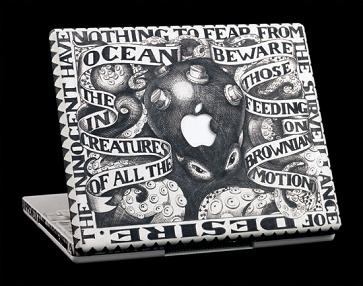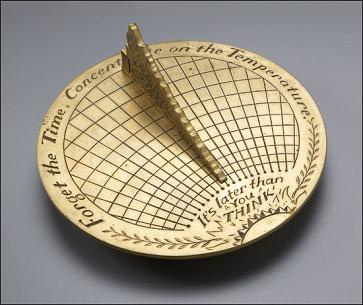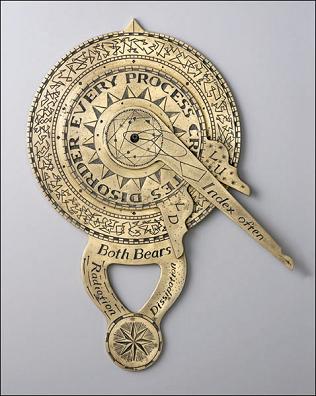
« PREVIOUS ENTRY
Chinese scientists unveil “the anti cloak” — technique for defeating invisibility shields
NEXT ENTRY »
Cows align themselves with magnetic north

I’m in love. Michael Dinges is a Chicago artist whose latest show — “Dead Reckoning” — consists of laptops engraved with spectacularly cool images, as well as a set of brass instruments styled after traditional sea-faring navigational tools (examples of those below, after the jump). When I saw the octopus-etched Apple laptop above, my heart began beating in a Fibonacci sequence. I should be unconscious any minute now.
In addition to being sumptuously awesome-looking, Dinges’ work is quite thought-provoking too, because he’s chewing over the relationship between how we use our tools to explore and exploit the natural world. You can read his artist’s statement here, or check out the essay about his work that the Packer Schopf Gallery — where this stuff is currently on display — commissioned, by Antonio Pocock:
When displayed together, Dinges’ obsolete navigational and timekeeping instruments and his engraved dead laptops present the evolution of technology and comment on our impulse and attempts to navigate the world. Estimating a ship’s location by tracking direction and distance traveled from a previously determined position using charts and instruments, rather than by direct observation of the stars and sky, is called “dead reckoning.” This term suggests that mediating experience and knowledge with various calculations and instruments removes man from the “live” world.
If we compare the manipulation of a seventeenth-century backstaff, for example, to that of a computer, we see that the use of navigation technology has become increasingly “dead,” or removed from reality. A backstaff required man to use his full body to gather information about his surroundings and to possess a command of physics to interpret that information. A computer hides its internal functions from the user, who passively absorbs the information displayed on its screen. As technology advances, the experience of navigation becomes increasingly abstract.
Pocock’s essay is a little overlarded with needless critspeak, but she does a great job of illuminating the cool areas Dinges explores: The history of sailors and warriors etching their tools to imbue them with mythic dimensions; the idea of navigation as a quest for meaning; the way that tools shape and constrain our thinking; the complexity and fragility of ecosystems; Brownian motion; Ouija boards; squirrels, and more! Man, I hope this show travels to New York so I can see firsthand.
Click on “more” to see images of a few of Dinges’ brass instruments …


I'm Clive Thompson, the author of Smarter Than You Think: How Technology is Changing Our Minds for the Better (Penguin Press). You can order the book now at Amazon, Barnes and Noble, Powells, Indiebound, or through your local bookstore! I'm also a contributing writer for the New York Times Magazine and a columnist for Wired magazine. Email is here or ping me via the antiquated form of AOL IM (pomeranian99).

ECHO
Erik Weissengruber
Vespaboy
Terri Senft
Tom Igoe
El Rey Del Art
Morgan Noel
Maura Johnston
Cori Eckert
Heather Gold
Andrew Hearst
Chris Allbritton
Bret Dawson
Michele Tepper
Sharyn November
Gail Jaitin
Barnaby Marshall
Frankly, I'd Rather Not
The Shifted Librarian
Ryan Bigge
Nick Denton
Howard Sherman's Nuggets
Serial Deviant
Ellen McDermott
Jeff Liu
Marc Kelsey
Chris Shieh
Iron Monkey
Diversions
Rob Toole
Donut Rock City
Ross Judson
Idle Words
J-Walk Blog
The Antic Muse
Tribblescape
Little Things
Jeff Heer
Abstract Dynamics
Snark Market
Plastic Bag
Sensory Impact
Incoming Signals
MemeFirst
MemoryCard
Majikthise
Ludonauts
Boing Boing
Slashdot
Atrios
Smart Mobs
Plastic
Ludology.org
The Feature
Gizmodo
game girl
Mindjack
Techdirt Wireless News
Corante Gaming blog
Corante Social Software blog
ECHO
SciTech Daily
Arts and Letters Daily
Textually.org
BlogPulse
Robots.net
Alan Reiter's Wireless Data Weblog
Brad DeLong
Viral Marketing Blog
Gameblogs
Slashdot Games